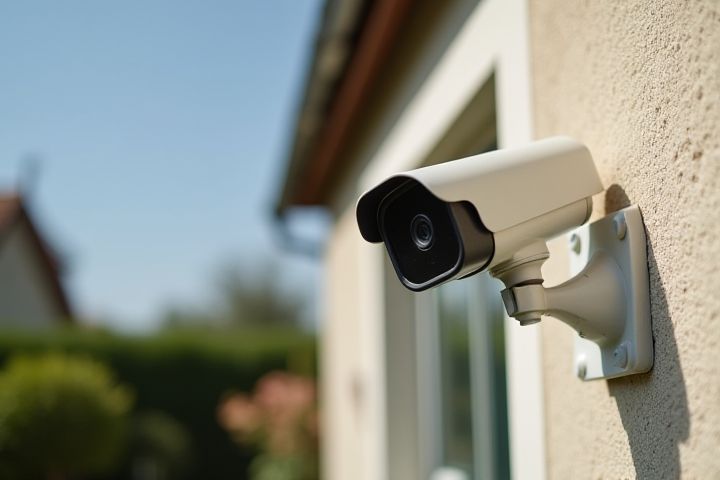
Position security cameras at entry points like doors and windows, as these areas are prime targets for intruders. Place cameras in the driveway to monitor vehicle activity and enhance surveillance of approaching visitors. Installing cameras in backyards and side alleys ensures coverage of less visible areas of your property. Consider placing indoor cameras in common areas, such as living rooms, to enhance safety and monitor for any suspicious activity. Your security system should include cameras with motion sensors and night vision capabilities for comprehensive protection.
Where Should Security Cameras Be On A House
Front Door Area
Position security cameras at the front door area to ensure maximum visibility and coverage. Install one camera directly above or to the side of the door, angled to capture facial details and package deliveries, ideally at a height of 8 to 10 feet. A second camera can cover the driveway and walkway, providing a broader view of potential approached threats. Ensure the cameras are equipped with night vision capabilities to maintain surveillance effectiveness even in low-light conditions, keeping your property secure 24/7.
Back Door Entrance
Position a security camera above the back door entrance to capture clear footage of anyone approaching. Ideally, install it at a height of 8 to 10 feet to prevent tampering while ensuring a wide field of vision. Ensure the camera covers areas like the doorframe, steps, and any nearby outdoor lighting. Consider using a camera with night vision capabilities to maintain surveillance effectiveness after dark, enhancing your home's security.
Ground-Floor Windows
Security cameras should be strategically placed to monitor all ground-floor windows, as these are often the most vulnerable entry points for intruders. Install cameras at an angle that provides a clear view of each window, ideally at a height of 8 to 10 feet to prevent tampering. Ensure that you have at least one camera for every two to three windows, allowing for overlapping coverage to eliminate any blind spots. You may also consider using motion-activated cameras that provide alerts directly to your smartphone, enhancing your home's security system efficiency.
Garage and Driveway
To enhance security, place a camera at the garage entrance to monitor any potential unauthorized access, as this is often a target for theft. Install another camera overlooking the driveway, ensuring it captures any vehicle activity, especially the license plates of incoming or outgoing cars. Positioning the cameras at a height of 8 to 10 feet helps avoid tampering while ensuring a wide field of view. Consider using infrared night vision capabilities to maintain surveillance effectiveness during low-light conditions, providing 24/7 security coverage.
Backyard or Patio
Position security cameras in your backyard and patio to maximize visibility and coverage. For the backyard, install cameras near entrances and on elevated surfaces to capture activity across the entire space, with a recommended height of 8 to 10 feet to avoid tampering. In the patio area, mount cameras that monitor main access points, such as doors or pathways, ensuring they have a clear line of sight without obstructions. Opt for cameras with at least 1080p resolution and night vision capabilities, ensuring your property's security is maintained 24/7.
Side Gates and Pathways
Position security cameras at side gates and along pathways to enhance safety around your home. Install cameras at a height of 8-10 feet for optimal coverage, capturing facial recognition and vehicle license plates when needed. Ensure cameras have a wide-angle lens to monitor the full length of pathways, ideally covering a distance of at least 30 feet. Utilize infrared night vision capabilities to maintain surveillance in low-light conditions, ensuring 24/7 protection for these vulnerable entry points.
Basement Stairs or Windows
Position security cameras strategically at basement stairs and windows for optimal coverage. A camera at your basement stairs can capture any unauthorized entry, providing clear footage of intruders in a vulnerable area. For window surveillance, install cameras to monitor points of access, particularly on ground-level windows, where break-ins are more common. Combining these two placements allows you to enhance overall security, as well-lit areas can deter potential threats while giving you peace of mind.
Off-Street Windows
Installing security cameras near off-street windows significantly enhances your home's security. Aim for a camera at each off-street window, ensuring they capture clear footage of potential intruders. Position cameras at a height of 8 to 10 feet to deter tampering while maintaining a wide field of view. Opt for models with night vision capabilities, allowing for 24/7 monitoring and ensuring you can see potential threats even in low-light conditions.
Second-Floor Windows
Position security cameras to monitor second-floor windows, ensuring they cover all potential entry points, particularly near accessible ladders or roofs. Install cameras at an angle that captures faces clearly while minimizing blind spots, ideally at a height of 8 to 10 feet for optimal visibility. Consider using high-resolution models with night vision capabilities to maintain surveillance during low-light conditions. By strategically placing these cameras, you enhance your home's security and deter potential intruders effectively.
Outdoor Structures (e.g., sheds)
Install security cameras around outdoor structures, such as sheds, at strategic points to maximize surveillance coverage. Position one camera facing the entrance of the shed, ensuring it captures any activity within a 20-foot radius, especially at night with infrared capabilities. Another camera should be installed at least 8 to 10 feet high on a nearby wall or post, providing a broad overview of the perimeter, including any paths leading to the shed. Consider adding motion detection features to alert you to suspicious movements and enhance security effectiveness.
